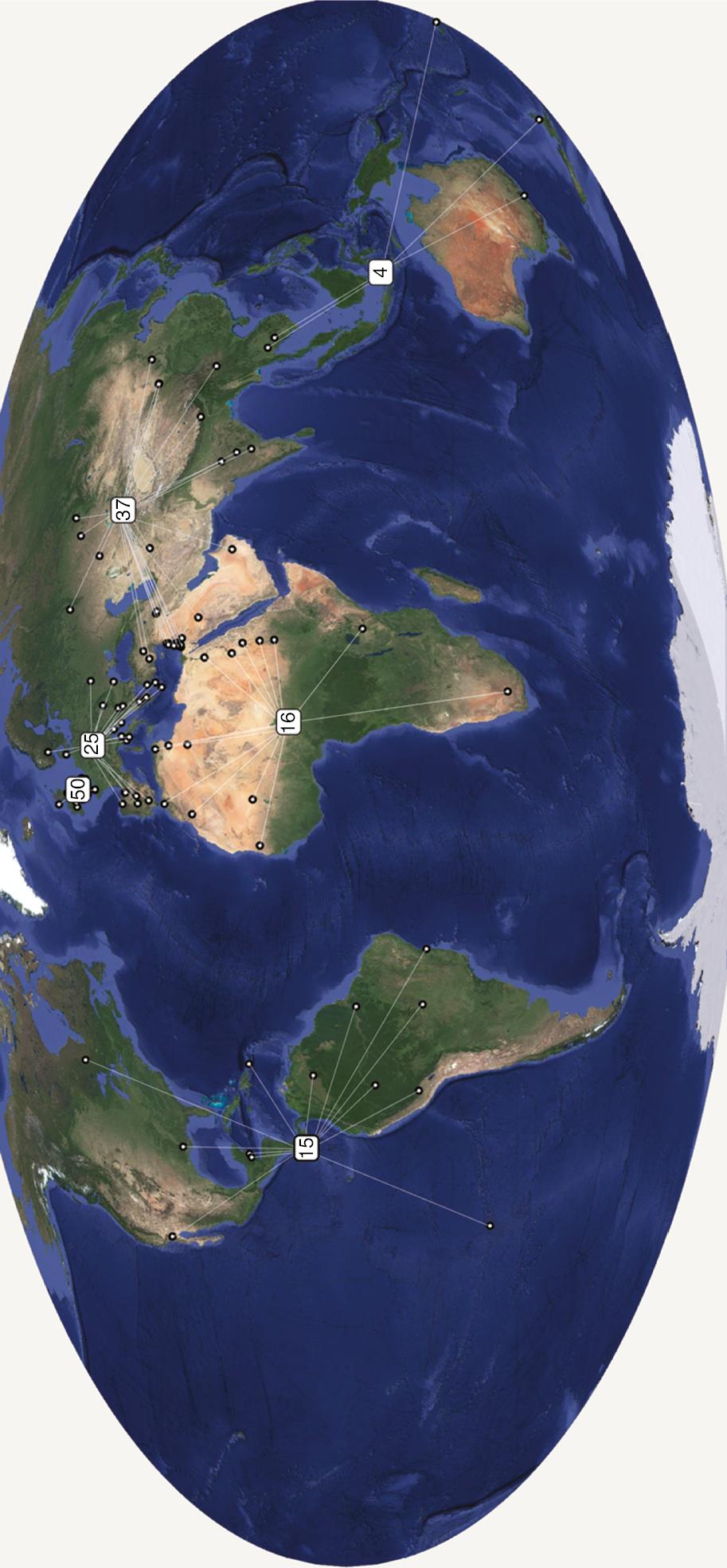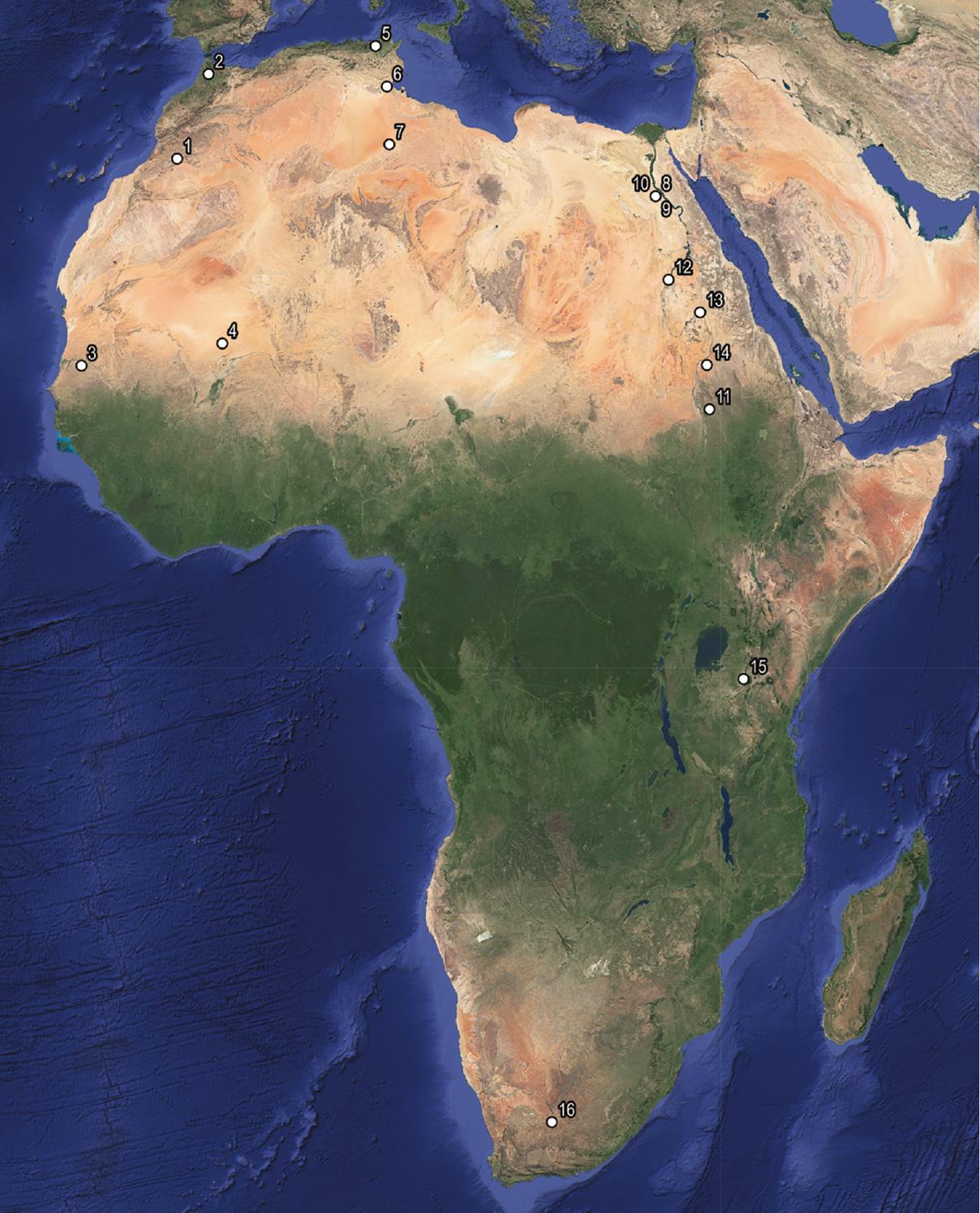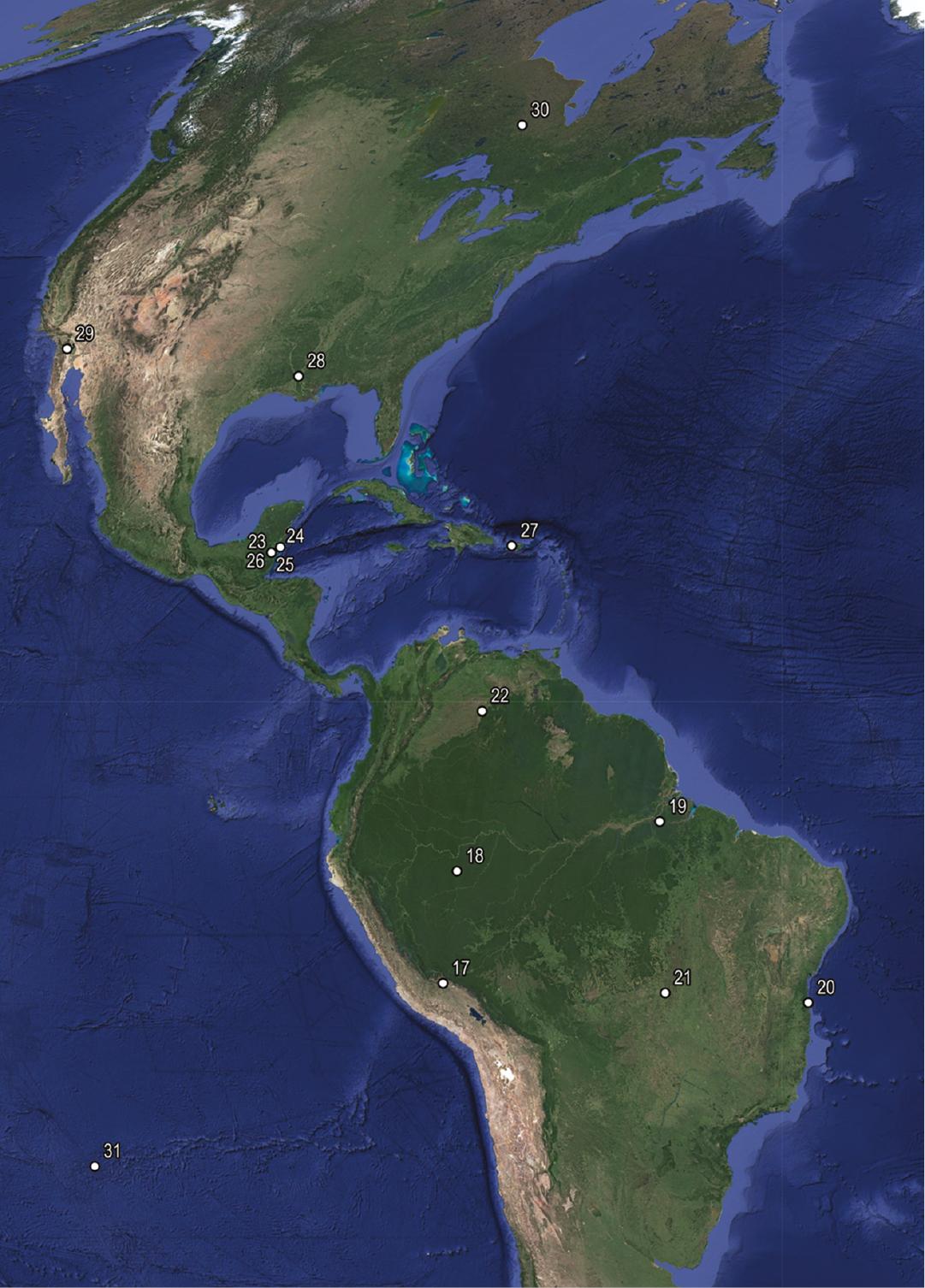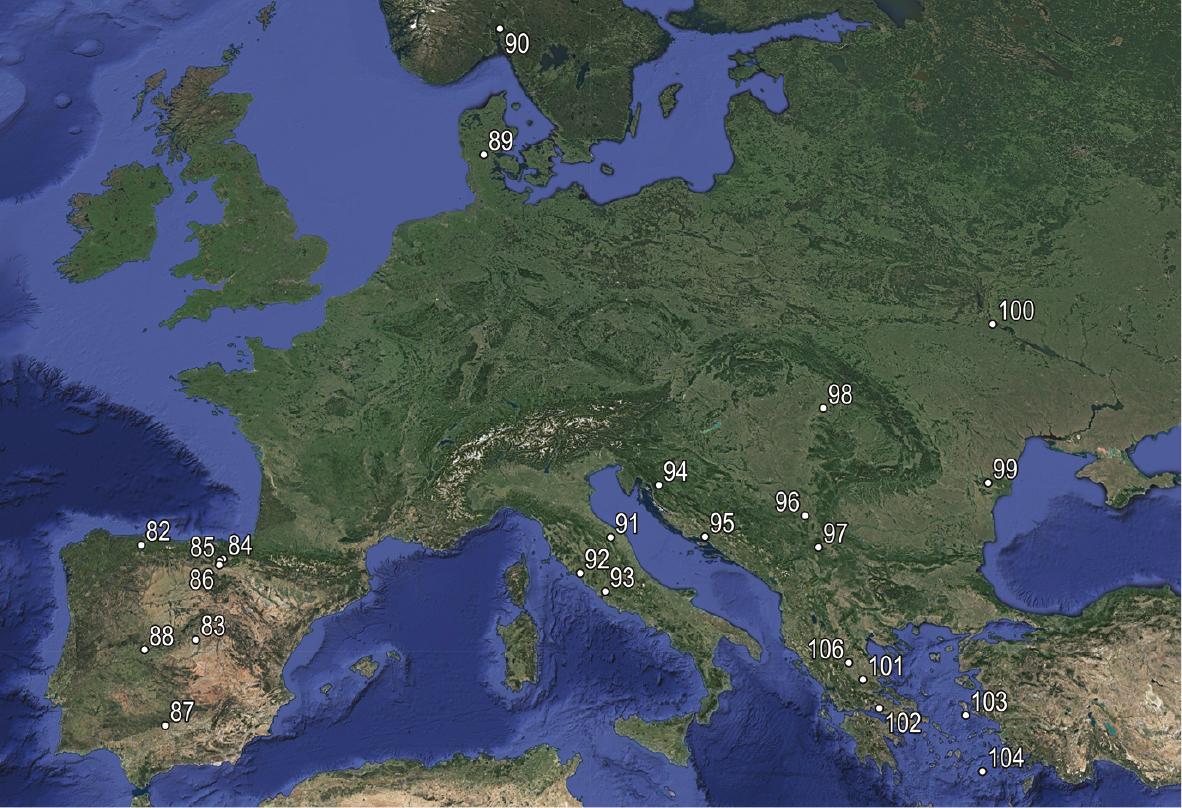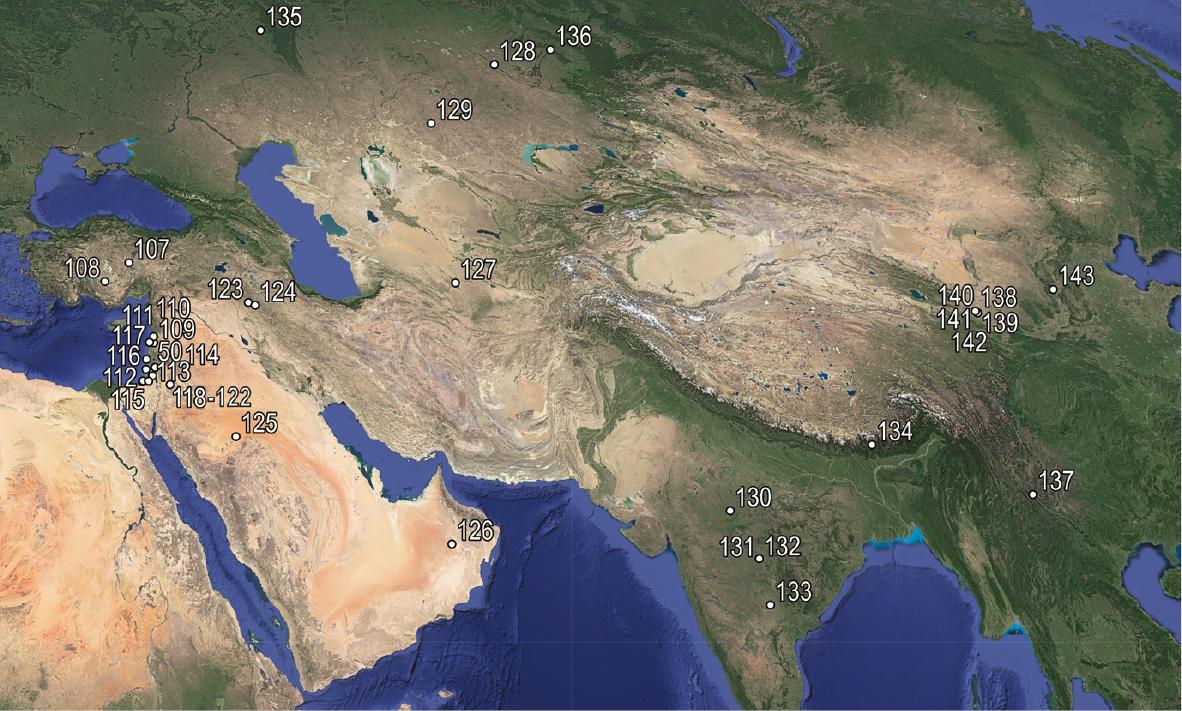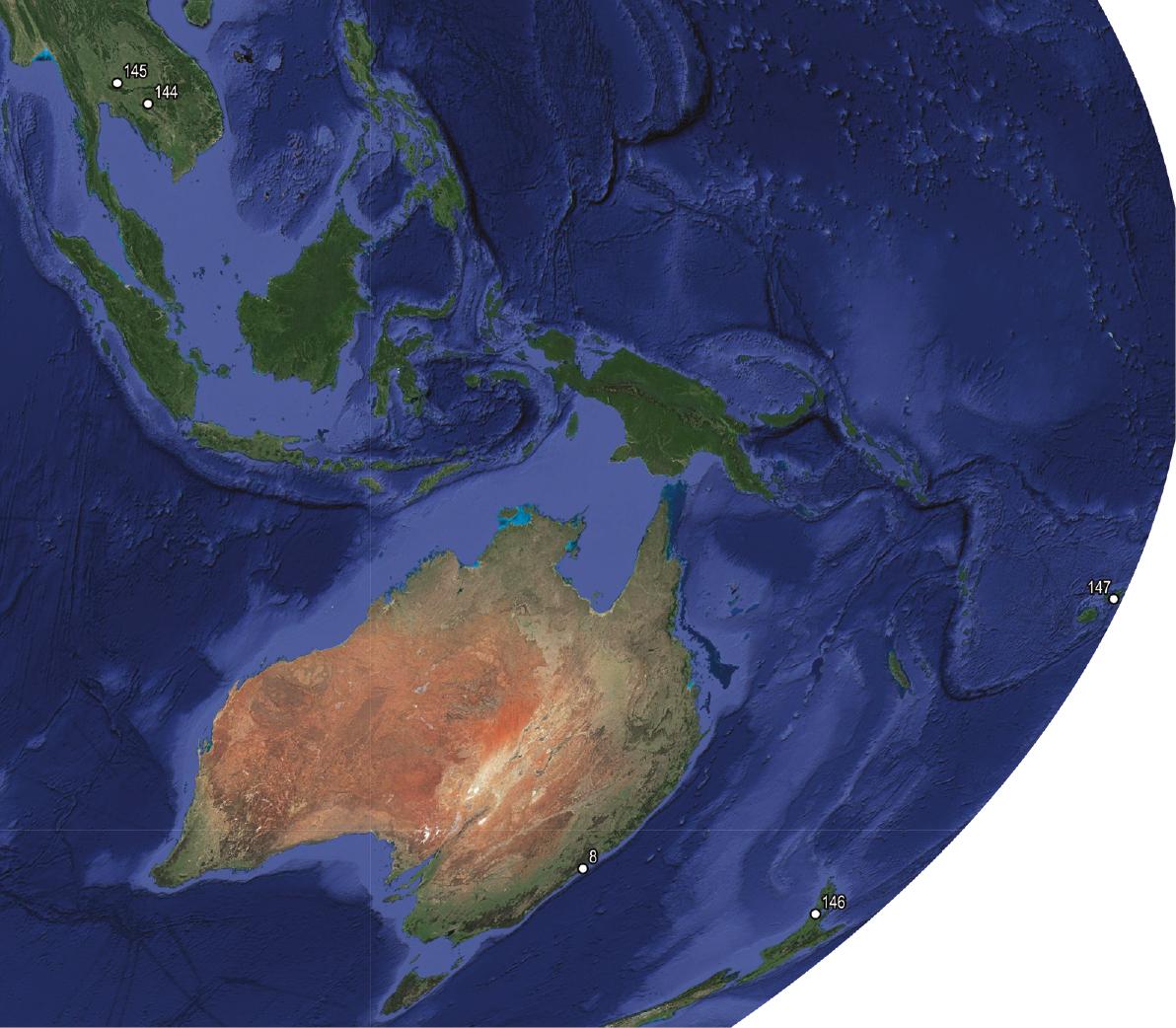The Institute of Archaeology continues to be a world-leading centre of global research in archaeology, cultural heritage and museum studies, as evidenced by the astounding scope of research projects currently engaged in by Institute staff. Below, some 163 ongoing projects are outlined and plotted on a world (see Figure 1, p. 56) and regional (see Figures 2 to 7, pp. 57–74) maps, showcasing the span of research. Of these, 16 projects are currently being undertaking in Africa, 15 across the Americas, 50 in Britain and Ireland, 25 in continental Europe, 37 in the Middle East, North, South and East Asia and four in Southeast Asia and Oceania. There are also 16 ongoing projects with a broader theoretical or conceptual focus – or which are more international in scope – which cannot be regionally situated and are thus not included on these maps. However, details are provided in the ‘International and non-geographical projects’ section (pp. 75–77). Further details of all the projects included here are available through the Institute’s website, either through individual staff pages or, for information, on the Institute’s various research centres, research networks and research themes; see the Institute’s Research Directory.
The world map employed here (Figure 1) is somewhat unconventional. An explanatory discussion summarising the decision-making process of drafting the world map for this feature, outlining choice of projection and form, the underpinning rationale and some theoretical considerations, can be found in a separate paper (‘North isn’t necessarily up: Map projections, the politics of cartography and their relevance to Archaeology’) in this issue.
Africa
Morocco, Wadi Draa. Wadi Draa Archaeological Project. Corisande Fenwick with the Institut National des Sciences de l’Archéologie et du Patrimoine and the University of Leicester.
Morocco, Volubilis. Volubilis Archaeological Project. Corisande Fenwick with the Institut National des Sciences de l’Archéologie et du Patrimoine.
Senegal, Saint Louis Region, Waalo. Oral History, Tumuli and Archaeology at the Root of Empire (ce 1000–1800). Kevin MacDonald with Sirio Canós Donnay (Instituto de Ciencias del Patrimonio, Santiago de Compostela, Spain), Ibrahima Thiaw (IFAN-Dakar) and Kate Welham (Bournemouth University).
Mali, Segou. Segou Project: Sorotomo and the Dodugu (ce 1000–1700). Kevin MacDonald with Nicholas Gestrich (Goethe-Universität Frankfurt am Main) and the Malian Institut des Sciences Humaines.
Tunisia, Jendouba. Bulla Regia Archaeological Project. Corisande Fenwick with the Institut National du Patrimoine de Tunisie.
Tunisia and Libya. Training in Action Project. Corisande Fenwick and Gai Jorayev with Durham University, King’s College London, the Institut National du Patrimoine de Tunisie and the Department of Antiquities, Libya.
Libya, Ghadamès. Ghadamès Archaeological Survey. Corisande Fenwick with the University of Leicester.
Egypt, UK and Australia, Cairo, London and Sydney. Egypt’s Dispersed Heritage: Views from Egypt. Alice Stevenson and Heba Abd el-Gawad with Tawesol, the Horniman Museum and Gardens and the University of Sydney Chau Chak Wing Museum.
Egypt. Origins of Nationhood: A New Chronology for Egyptian State Formation. David Wengrow with the Research Laboratory for Archaeology and History of Art, Oxford University.
Egypt. Decolonising Archaeology: Ethnographies in Egypt. Stephen Quirke with New Hermopolis, Tuna al-Jabal, Minya and Fayoum University.
Sudan, Jebel Moya. Michael Brass, Dorian Fuller and Chris Stevens.
Sudan, Shalfak. Shalfak Archaeological Mission (SAM). Claudia Naeser and Wolfram Grajetzki.
Sudan, Mograt Island. Mograt Island Archaeological Mission. Claudia Naeser with the National Corporation for Antiquities and Museums.
Sudan, Shaqadud. Czech–British expedition to the Western Butana; Mesolithic and Neolithic Excavations and Survey. Dorian Fuller with Ladislav Varadzin and Lenka Varadzinová (Czech Institute of Archaeology).
Tanzania, Olduvai Gorge. Renata Peters and Ignacio de la Torre (honorary) with the University of Wisconsin and the Department of Antiquities, Tanzania.
South Africa, Cape Town, Pretoria, Polokwane and Grahamstown. The Cultural Cost of Development. Rachel King with Keneiloe Molopyane (University of Witwatersrand).
Americas
Peru, Cuzco. Ceramic Production and Monumental Stonework during the Emergence and Expansion of the Inca State. Bill Sillar with the University of North Carolina, Charlotte and the Ministerio de Cultura, Cuzco.
Brazil, Amazonia, Alto Solimões. Barkcloth from the Brazilian Amazon. Renata Peters with the Museu de Arqueologia e Etnologia, Universidade de Sao Paulo and representatives from the Tikuna of Benjamin Constant.
Brazil, Caxiuanã. Geoarchaeology of Caxiuanã. Manuel Arroyo-Kalin in partnership with Museu Paraense Emílio Goeldi (MPEG).
Brazil, Bahia, Olivença. The Sacred Cloaks of the Tupinambá. Renata Peters with Ellen Pearlstein (University of California, Los Angeles), Marina Pugliese (Comune di Milano, Italy) and representatives from the Tupinambá of Olivença.
Brazil. Ancestral Indigenous Landscapes in the Upper Negro River. British Academy project led by Manuel Arroyo-Kalin, in partnership with the Federal University of São Carlos (UFSCar), the Museu da Amazônia (MUSA), the Instituto Socioambiental (ISA) and MPEG.
Colombia, Municipality of Puerto Carreño. Archaeological Survey in the Colombian Orinoco, Northeast Vichada. José R. Oliver (PI) and Manuel Arroyo-Kalin with José Luis Socarrás (Co-PI), the Universidad de Externado and the Instituto Colombiano de Antropología e Historia (ICAHN).
Belize, Lamanai. Study of Monuments with Inscriptions and Ceramic Studies. Elizabeth Graham and David Pendergast with Christophe Helmke (University of Copenhagen), Jim Aimers (State University of New York at Geneseo) and Eva Jobbová (Trinity College, Dublin).
Belize, Ambergris Caye. Marco Gonzalez Archaeological Project: Excavations Focused on Maya ‘Collapse’ Periods of Disruption and Environmental Impacts. Elizabeth Graham and David Pendergast with Christophe Helmke (University of Copenhagen) and Jim Aimers (State University of New York at Geneseo).
Belize, Lamanai and Marco Gonzalez. Atypical Burial Practices as a Proxy for Sociopolitical and Cultural Change during the ‘Collapse’ in the Eastern Maya Lowlands. Panos Kratimenos and Elizabeth Graham with Lana Williams and Sandra Wheeler (University of Central Florida) and Doug Kennett (University of California, Santa Barbara).
Belize, Lamanai. Soils and Land Use in an Urban Context: Past, Present and Future – Lamanai, Belize from 1600 bce to ce 2022. Francesca Glanville-Wallace, Elizabeth Graham and Manuel Arroyo-Kalin.
Puerto Rico, Utuado. Bateyes de Viví. José R. Oliver.
USA, Louisiana. Cane River African Diaspora Archaeology Project: The Pierre Metoyer Plantation. Kevin MacDonald with the US National Park Service.
USA, Anza-Borrego Desert State Park, California. Ceramic Production and Distribution at Late Prehistoric Hunter-Gatherer Seasonal Occupation Site CA-SDI-813. Patrick Quinn with the San Diego Archaeological Center, California.
Canada, Ontario. Complex Hunter-Gatherers of the Trent Valley. Excavation of a Set of Archaic through Middle Woodland Sites. Sue Colledge with the Department of Anthropology, Trent University, Ontario.
Easter Island, Rapa Nui. Landscapes of Construction Project. Sue Hamilton with Bournemouth University, the University of Manchester, the University of the Highlands and Islands, the Universidad de Chile, Hawai‘i Pacific University, the Rapa Nui National Parks Authority and the Museo Antropológico Padre Sebastián Englert.
Britain and Ireland
Ireland. Cultivating Societies: Assessing the Evidence for Agriculture in Neolithic Ireland. Sue Colledge with Queen’s University, Belfast and the Institute of Archaeology, Oxford.
Ireland, Dublin. Metalworking in Viking Dublin. Justine Bayley with the National Museum of Ireland.
Scotland, South Uist, Howmore. Andrew Reynolds.
Wales, Pembrokeshire, Whitesands Bay. St Patrick’s Chapel Excavation Project. Katie Hemer with Dyfed Archaeological Trust and the Pembrokeshire Coast National Park Authority.
Wales, Caerleon, Priory Field. Andrew Gardner with Cardiff University, Cadw, National Roman Legion Museum, Caerleon and the National Museum Wales, Cardiff.
Jersey. La Cotte de St Brelade. Matt Pope with Beccy Scott (British Museum) and Chris Stringer (Natural History Museum).
Jersey, Les Varines. Ed Blinkhorn and Matt Pope with Beccy Scott (British Museum).
England, London. Multiple projects conducted by Archaeology South-East (ASE). Stationers Hall: Medieval and Post-Medieval Structural Remains (Ian Hogg); Bevis Marks Synagogue: Roman, Medieval and Post-Medieval Structural Remains Relating to Inn Building (Tom Rugg/Ian Hogg); Fulham Town Hall Historic Building Recording (Susan Chandler).
England, Essex. Multiple projects conducted by ASE. River View, Witham: Roman Pottery Kilns (Adam Dyson); Land North of Heybridge: Large-Scale Evaluation (300+ Trenches) followed by Excavation of Prehistoric Landscape including Bronze Age Cremations, Ring Ditches and Post-Built Structures (Robert Cullum); Berechurch Hall Road, Colchester: Late Iron Age–Roman Field System and Enclosures with Cremations (James Alexander).
England, Kent. Multiple projects conducted by ASE. Frindsbury: Geoarchaeological and Archaeological Fieldwork of Extensive Palaeolithic and Late Iron Age–Roman Landscape including Roman Burials (Matt Pope, Letty Ingrey and Giles Dawkes); New Romney: High Medieval Building and Associated Canalised Sea Inlet (Jake Wilson); Dartford Gunpowder Works: Conservation Management Plan (Michael Shapland).
England, West Sussex. Multiple projects conducted by ASE. Storrington: Late Iron Age–Roman Settlement; Sefter Road, Bognor Regis: Bronze Age, Iron Age and Roman Features (Teresa Vieira); Chichester Cathedral West Tower: Historic Building Investigation (Michael Shapland); Loxwood: Iron Age Settlement (Teresa Vieira).
England, East Sussex. Multiple projects conducted by ASE. Hailsham: Late Iron Age/Roman Field System with Salt Working Evidence and Medieval Field Systems (Lucy May); Bexhill: Multi-Period Landscape Excavation Following Large-Scale Evaluation (Teresa Vieira and Lucy May); Seaford Head: Historic England Funded Pilot Study to Rapidly Record Sites Threatened by Increased Coastal Erosion Brought about by Climate Change (Ed Blinkhorn/Richard James/Emily Johnson, Jon Sygrave/Vas Tsamis); Tithe Barn, Falmer Court Farm, Falmer Historic Building Recording (Amy Williamson).
England, Suffolk. Multiple projects conducted by ASE. Henley Gate, Ipswich: Early Iron Age Occupation Site, Early Roman Boundaries and Enclosure and Medieval Field System (Angus Forshaw); Bramford: Bronze Age and Anglo-Saxon Landscape with Burial and Settlement Evidence (James Alexander); Westerfield, Ipswich: Prehistoric and Roman Landscape Settlement and Funerary Landscape (Kieron Heard).
England, Tower of London. The Tudor Mint. Justine Bayley and Harriet White.
England, London, Islington. Elthorne Park and Islington Community Archaeology Project. Charlotte Frearson with Islington Museum and Islington Council.
England, London School of Economics. Mid- to Late Saxon to Post-Medieval Urban Archaeology. Sarah Ritchie (ASE).
England, London, Wild Rents, Bermondsey. An Eighteenth- to Nineteenth-Century Tannery. Hayley Nicholls (ASE).
England, London. The Gresham Ship Project. Dean Sully.
England and Palestine, UCL Petrie Museum of Egyptian and Sudanese Archaeology. Collections in Exile, Persons in Exile: Rethinking the Petrie Palestinian Collection. Beverley Butler with UCL, the Tawfik Canaan Collection and Birzeit University.
England, Devon, Buckfast. Andrew Reynolds with Newcastle University.
England, east Wiltshire. Great Bedwyn Research Project. Stuart Brookes and Andrew Reynolds.
England and Wales. Stones of Stonehenge. Mike Parker Pearson with Bournemouth University and the University of Southampton.
England, Cheshire. Blackden Project. Mark Roberts.
England, Sussex and Hampshire Coastal Plain. The Exotic Rock Project. Mark Roberts.
England, Boxgrove. Mark Roberts, Simon Parfitt and Matt Pope.
England, West Sussex. Bow Hill Project, The Slindon Bottom Project, The Downley Project, The Goodwood Estate Monument Survey. Mark Roberts with Robert Kaleta (ONS).
England, Hampshire. Chilton Candover. Tim Schadla-Hall and colleagues.
England, Portsmouth. Tudor Warship Mary Rose. Martin Bridge with the Mary Rose Trust.
England, West Sussex, Highdown. Late Roman/Early Anglo-Saxon Cemetery. Sue Harrington in collaboration with James Sainsbury and Worthing Museum, with support from ASE.
England, Hertfordshire (and neighbouring counties). Geophysical Surveys at Verulamium and Other Sites. The Community Archaeology Geophysics Group led by Kris Lockyear and Ellen Shlasko.
England. The Portable Antiquities Scheme Database as a Tool for Archaeological Research. Sally Worrell with Roger Bland (University of Cambridge) and Katherine Robbins (British Museum).
England, Guildford, Surrey, Kingsmead Quarry (Horton), Middlesex and Farndon Fields, Nottinghamshire. Richard MacPhail with Oxford Archaeology, Oxford University, Wessex Archaeology, and Nottingham County Council.
England, Cambridge. Pesticides, Toxicity and Urban Nature: A Comparative Social Study of Environmental World-Views and Practices. Julia Shaw with Andrew Barry (UCL Geography).
England, Cambridgeshire, Huntingdon. Late Roman Dark Earth (Headland-MOLA Infrastructure). Richard MacPhail.
England, Clandon Park. Hinemihi Maori Meeting House: People-Based Conservation. Dean Sully with Ngäti Ragana, Ngäti Hinemihi, New Zealand Historic Places Trust, the National Trust and ICCROM.
England, Suffolk. Rendelsham. Rendlesham Revealed Project: Anglo-Saxon Life in Southeast Suffolk. Chris Scull and Stuart Brookes with Suffolk County Council.
England, Canterbury. An International Glass Trade: Establishing the Origins of the Coloured Glass in the Early Stained Glass Windows of Canterbury Cathedral. Ian Freestone with Tim Ayers (University of York) and Leonie Seliger (Canterbury Cathedral). Funded by a British Academy small grant, this project uses in situ pXRF analysis to investigate the origins of late-twelfth- and early-thirteenth-century window glass.
England. Stability of Glass in English Heritage Collections. Antanas Melinis and Ian Freestone with English Heritage.
England, Yorkshire. Boynton House. Tim Shadla-Hall with Durham University.
England. Landscape Futures and the Challenge of Change: Towards Integrated Cultural/Natural Decision Making. Rodney Harrison (Co-I) with Caitlin DeSilvey (PI; University of Exeter), Hannah Fluck (Co-I; Historic England), Rosie Hails (Co-I; National Trust) and Ingrid Samuels (Co-I; National Trust). Project Partner: Natural England. Funded by AHRC.
England, Lincoln. Metalwork and Metalworking in Viking Age Lincoln. Justine Bayley with the Institute of Archaeology, Oxford.
England, Chichester. Romanisation of Iron Age Precious Metals. Justine Bayley.
England. Medieval Music Wire. Justine Bayley.
England. Roman and Medieval Silver Production and Refining. Justine Bayley.
Britain. Roman Metalworking Ceramics. Ian Freestone with Carlotta Gardner (British School at Athens), MoLA and Demokritos, Athens.
Britain. Technology of Roman Cameo Glass. Ian Freestone with the British Museum and The Glassmakers.
Britain. Composition, Corrosion and Production of Medieval Window Glass. Ian Freestone with Tim Ayers (University of York), York Glaziers Trust and Royal Holloway University of London.
Britain. Bronze Age Axes. Andrew Bevan and partners, including the British Museum, Amgueddfa Cymru-National Museum, Wales and National Museums, Scotland.
United Kingdom. MicroPasts. Andrew Bevan with Chiara Bonacchi (University of Stirling), Daniel Pett and Jennifer Wexler (Fitzwilliam Museum, Cambridge), the British Museum and other museums, universities and archives in Europe, Asia and Northern America.
United Kingdom. Comparative Models of Megalithic Landscapes in Neolithic Atlantic Europe (MegaScapes). Miguel Carrero-Pazos, Andrew Bevan and Mark Lake with Joanna Bruck (University College Dublin), Serge Cassen (University of Nantes) and Antón A. Rodríguez Casal (University of Santiago de Compostela).
Europe
Spain, Villaneva de Santo Adriano. Archaeology of the Commons in Asturias, Spain. Gabriel Moshenska with Jesús Fernández Fernández (La Ponte Ecomuseum).
Spain and Portugal. Multiple locations. IdaVe Project, Village of Idanha-a-Velha, Beixa Baja; Los Hitos, Arisgotas; Castilla La-Mancha. Urban Landscape of Power in the Iberian Peninsula from Late Antiquity to the Early Middle Ages (ULP.PILAEMA). Andrew Reynolds with Isabel Sánchez Ramos (Universidad Pablo de Olavide), Jorge Morín de Pablos (Audema Madrid), Antonio Malalana (Universidad San Pablo Ceu, Madrid) and Jose Ramón González de la Cal (Universidad de Castilla-La Mancha).
Spain, Basque Country. Vitória, Aistra. Andrew Reynolds with the University of the Basque Country.
Spain, Burgos. Arganzón Castle. Juan Antonio Quirós.
Spain, Álava. Lantarón Castle. Juan Antonio Quirós.
Spain, Córdoba. Heritage of Historic Cities and Multi-Culturalism. Beverley Butler with Córdoba University.
Spain, Vera Valley. VERASUR, Discovering the Long-Term Human Occupation in the West Mediterranean: Archaeological Survey in the Vera Depression (Almería, Spain). Borja Legarra Herrero with Mercedes Murillo Barroso (University of Granada, Spain).
Denmark, Coastal Jutland. Bronze Age Burial Mound (Østfyns Museer). Richard MacPhail.
Norway, Oslo (and surrounding area): Medieval City and Oslo Harbour Sediments and Shipwrecks; Løten, Hedmark: Iron Age Upland Cairn Fields and Iron Working; Avaldsnes, Karmøy, Rogaland: Iron Age and Medieval Royal Manor; Trondheim and north-west coast: Mesolithic to Iron Age Settlements. Richard MacPhail with the Culture History Museum and Oslo University, The Norwegian Institute for Cultural Heritage Research and the Norwegian University of Science and Technology.
Italy, Marche. Upper Esino Valley Survey. Corinna Riva.
Italy, Vulci. The Ports of Etruscan Vulci: Understanding the Connectivity of a Major Ancient Mediterranean City. Corinna Riva (co-ordinator) and Kris Lockyear with Soprintendenza archeologia, belle arti e paesaggio per l’area metropolitana di Roma, la provincia di Viterbo e l’Etruria meridionale, Parco Archeologico di Vulci and the British School at Rome.
Italy. Medieval Glass from Venice: Technology, Raw Materials and the Trade with the Eastern Mediterranean. Veronica Occari, Corisande Fenwick and Ian Freestone with CNRS, Orleans, France and Aarhus University.
Croatia. Composition, Technology and Origins of Iron Age Beads in Croatia. Ian Freestone with Ana Franjić, Lower Carniola Museum, Zagreb Archaeological Museum, Muzej Slavonije, Šibenik City Museum, University of Zagreb, University of Zadar, Zadar Museum of Ancient Glass, Arheološki Muzej Istre, Zemaljski Muzej, Bosne I Hercegovine, Gradski Muzej Karlovac, Gradski Muzej Virovitica, Vinkovci City Museum, the Zagreb Institute of Archaeology, ETH Zurich and Aarhus University.
Croatia, Dalmatia. Economy of Pre-Roman Adriatic Communities: Amphora Production and Trade Patterns in a Changing World (EPRAC). Patrick Quinn with Maja Mise (University of Cambridge), Archaeological Museum, Split, Municipal Museum Kastela, Citi Museum Stari Grad, the Departments of Underwater Archaeology at the University of Zadar and Croatian Conservation Institute and the Missouri University Research Reactor.
Serbia. Glass from Felix Romuliana (Gamzigrad, Serbia). Use of microprobe analysis to interpret late Roman glass assemblages. Ian Freestone with the Institute of Archaeology, Belgrade, the National Museum, Belgrade, and the National Institute of Archaeology (Sofia, Bulgaria).
Serbia, Pločnik, near Prokuplje. Vinča Culture Site. Miljana Radivojevic with Julka Kuzmanovic Cvetkovic (Homeland Museum, Toplica).
Romania, Taşnad. Excavation of a Criş Settlement. Ulrike Sommer with Satu Mare Museum.
Romania, Noviodunum, Tulcea. Kris Lockyear with the Fitzwilliam Museum, Cambridge and Southampton University.
Ukraine, Nebelivka Tripillia. Geoarchaeological Research at Mega-Site. Manuel Arroyo-Kalin with Durham University.
Greece, Neo Monastiri/Phthiotis. Koutroulou Magoula Archaeology Project: From the Neolithic to the Present. Vasilis Tsamis with the British School at Athens, Yannis Hamilakis (Brown University) and Nina Kyparissi-Apostolika (Greek Archaeological Service).
Greece, Hosios Loukas and the Parthenon. Origin of Glass in Mid-Byzantine Mosaics. Trace element analysis to determine the origins of a poorly understood group of glass. Chongwen Liu (MSc student), Ian Freestone, Mike Charlton and Andrew Meek (honorary) with the British Museum.
Greece, Chios. Emborio Hinterland Project. Andrew Bevan (co-lead) and Brenna Hassett with the Greek Archaeological Service (Olga Vassi [co-lead, synergast], Despoina Tsardaka, Chios Ephorate).
Greece, Astypalaia, Dodecanese. Cemeteries on the Island of Astypalaia. Simon Hillson.
Greece, Crete. The Knossos Urban Landscape Project. Todd Whitelaw with the British School at Athens and Herakleion Ephoreia of the Greek Archaeological Service.
Greece, Crete. Minoan Gold: An Archaeometallurgical Analysis of Crete’s Place in the East Mediterranean World. Borja Legarra Herrero with Marcos Martinón-Torres (University of Cambridge).
Middle East, North, South and East Asia
Turkey. Technology of Seljuq Ceramics and Glass from Kubad Abad. Ian Freestone with the University of Çukurova and the University of Ankara.
Turkey, Boncuklu Höyük. Boncuklu Höyük Project. Louise Martin with the University of Liverpool, the University of Queensland, the University of Reading and Harvard University.
Lebanon. Hellenistic and Early Roman Glass from Beirut. Ian Freestone with the Katholieke Universiteit Leuven.
Lebanon, Qadisha. Qadisha Valley Project. Epipalaeolithic–Neolithic Excavations at Moghr el-Ahwal. Andrew Garrard, Kevan Edinborough, Yvonne Edwards, Richard Macphail and Katherine (Karen) Wright with the Lebanese University, Beirut and Lampeter.
Lebanon, Beirut. Beirut Souks. Dominic Perring (CAA/ASE) and Tim Williams with the American University of Beirut.
Palestine. Tell Ruqeish and Tell es-Sakan. Gaza Maritime Archaeology Project (GAZAMAP). Georgia Andreou with Yasmeen El-Khoudary (Council for British Research in the Levant), Ayman Hassouna (Islamic University of Gaza) and Maritime Endangered Archaeology in the Middle East and North Africa (MarEA; University of Southampton). Funded by the Honor Frost Foundation.
Israel/Palestine, Sheikh Jarrah. Understanding Heritage Wellbeing: Traditional Healers and Eye Care. Beverley Butler with the Eye Hospital, Order of St John.
Israel, Jordan Valley. Tel Bet Yerah. Early Bronze Age and Early Islamic Period. David Wengrow with Raphael Greenberg (Tel Aviv University).
Israel. Glass from the Sea. Ian Freestone with the Israel Antiquities Authority.
Israel, Apollonia. Byzantine Glass Furnaces at Apollonia. Chen Chen and Ian Freestone with Ruth Jackson Tal (Israel Museum) and Oren Tal (Tel Aviv University).
Israel, Haifa. Roman Glass Production at Jalame, near Haifa. Chen Chen and Ian Freestone with the Corning Museum of Glass, New York, the Israel Antiquities Authority and Aarhus University.
Jordan. Talbiyeh and other Palestinian Refugee Camps in Jordan. Beverley Butler with Petra University, Amman.
Jordan. Kharaneh IV. Epipalaeolithic Excavations. Louise Martin with the University of California (Berkeley).
Jordan. Azraq Project. Epipalaeolithic–Neolithic Excavations. Andrew Garrard, Sue Colledge, Louise Martin and Katherine (Karen) Wright with the University of Liverpool, the University of Belfast, the University of California, Davis and the Centre national de la recherche scientifique, France.
Jordan. Glass Production in Roman and Byzantine Jerash. Ian Freestone with UrbNet and Aarhus University.
Jordan. Glass Production in Khirbet edh-Dharih. Ian Freestone with Yarmouk University.
Iraqi Kurdistan. Later Prehistory of the Shahrizor Plain. David Wengrow with the Directorate of Antiquities, Suleymaniyah Province.
Iraq, Rania Plain. Girdi Bazar Project. Mark Altaweel with LMU Munich.
Saudia Arabia, Nefud Desert, Jubbah Oasis. Palaeodeserts Project. Louise Martin with Maria Guagnin (Freie Universität Berlin), Michael Petraglia (Max-Planck-Institut für Menschheitsgeschichte) and team.
Oman, Dhofar and multiple locations in southern Oman. ASOM Project (Ancient Socioecological Systems in Oman). Louise Martin with Joy McCorriston, Mark Mortiz, Ian Hamilton (Ohio State University) and team.
Turkmenistan. Ancient Merv Project. Tim Williams and Gai Jorayev with the Ministry of Culture of Turkmenistan, ‘Ancient Merv’ State Archaeological Park, Centre for Applied Archaeology, Heritage Without Borders, CraTerre-ENSAG, Grenoble, Oxford University, the US Embassy in Turkmenistan and CyArk.
Kazakhstan, Pavlodar. Landscape and Metal Production at the Late Bronze Age Site of Semiyarka. Miljana Radivojevic with Dan Lawrence (Durham University) and Victor Merz (Pavlodar State University).
Kazakhstan, Taldysai. The Large-Scale Production of Copper in Central Kazakhstan. Miljana Radivojevic with Antonina Ermolaeva (Institute of Archaeology, Almaty).
India, Sanchi. Sanchi Survey Project. Julia Shaw with the Department of Archaeology, Museums and Archives, Madhya Pradesh, Bhopal and the University of Leeds.
India. Religion and ‘Nature’ in Ancient India. Julia Shaw.
India. Technology of Northern Black Polished Ware. Scientific Analysis of this Important Iron Age Ceramic. Ian Freestone with K. Krishnan (The Maharaja Sayajirao University of Baroda).
India, Gajagirigutta. India: Iron Age. Dorian Fuller with K. P. Rao (University of Hyderabad).
Kingdom of Bhutan. National Inventory. Tim Williams and Andrew Bevan with the Department of Culture, Bhutan, the National Commission of UNESCO, Bhutan and Cultural Heritage Information Consultants.
Russia, Muradimovskoe Poselnie, near Ufa. Late Bronze Age Site with Metallurgical Production. Miljana Radivojevic with the Bashkir State Pedagogical University.
Russia, Podsinyushka, near Barnaul. Early Bronze Age Site in the Altai Mountains. Miljana Radivojevic with Sergey Grushin (Altai State University).
China, Yunnan Province, Haimenkou and Baiyangcun. Early Rice Project/Comparative Pathways to Agriculture. Chris Stevens, Dorian Fuller, Ling Qin, Rita Dal Martello and Eleanor Kingwell-Banham with Peking University and the Institute of Cultural Heritage and Archaeology of Yunnan.
China, Xi’an. First Emperor’s Mausoleum. The Making of the Terracotta Army. Andrew Bevan, Janice Li, Thilo Rehren, Patrick Quinn, Sue Hamilton and Mike Charlton with Marcos Martinón-Torres (University of Cambridge) and the Museum of Emperor Qin Shihuang’s Mausoleum, Xi’an.
China, Gansu Province. Early Glass and Pigments from Majiayuan Cemetery, Gansu Province. Thilo Rehren, Yi-Xian Lin and Ian Freestone with the Gansu Provincial Institute of Archaeology.
China. Development of Early White Porcelain in China. Ian Freestone with Shan Huang and the Institute of Archaeology, Chinese Academy of Social Sciences, Beijing.
China. Multiple projects: Opium War: Digital Interpretation of Archaeological Sites and Finds for Museum-Based Presentation; Naval Battle Museum: Digital Interpretation of Archaeological Sites and Finds for Museum-Based Presentation; Chinese Exported Fans: Digital Interpretation of Archaeological Sites and Finds for Museum-Based Presentation. Jia Liu (CAA).
China. Composition, Technology and Origins of Qing Dynasty Porcelain Enamels. Ian Freestone with Cranfield University.
China, Shanxi Province. Survey and Digital Documentation of Endangered Temple Wall Paintings. CAA and ICCHA with Zhejiang University.
Southeast Asia and Oceania
Cambodia, Ta Phrom and Angkor Wat. Early Rice Project. Cristina Castillo and Dorian Fuller with Miriam Stark (University of Hawai‘i at Mānoa), Roland Fletcher and Alison Carter (University of Sydney).
Thailand, Non Ban Jak and Ban Non Wat. Cristina Castillo and Dorian Fuller with Charles Higham and Ratchanie Thosarat (University of Otago) and Nigel Chang (James Cook University).
New Zealand, Auckland. Interrogating Archaeological Data for Climatic Information. Martin Bridge with the Auckland University Dendrochronology Laboratory.
Fiji, Nukabaluvu. Early Rice Project. Dorian Fuller with Sharyn Jones (Northern Kentucky University).
International and non-geographical projects
Towards Inclusive Digital Museum Innovation. Theano Moussouri with Young Yim Doh (Graduate School of Culture and Technology, Korea Advanced Institute of Science and Technology).
Reimagining Museums for Climate Action. Rodney Harrison (co-lead) and Rowan Gard (postdoc) with Colin Sterling (co-lead; University of Amsterdam), Henry McGhie (Curating Tomorrow) and the Glasgow Science Centre. Funded by AHRC.
CHEurope: Critical Heritage Studies and the Future of Europe: Towards an Integrated, Interdisciplinary and Transnational Training Model in Cultural Heritage Research and Management (Marie Sklodowska-Curie Action Innovative Training Network). Rodney Harrison and Beverly Butler with the University of Gothenburg, the University of Amsterdam, ISCTE-University Institute of Lisbon, the Spanish National Research Council (Consejo Superior de Investigaciones Científicas), the University of Hasselt, Utrecht University, the Istituto per I Beni Artistici, Culturali e Naturali della Regione, Emilia Romagna and 21 international heritage and museum sector partner organisations.
i-Treasures: A Focus on Corsica, Sardinia, the Walloon Region of Belgium and Northern Greece. Marilena Alivizatou.
Coin Hoards of the Roman Republic. Kris Lockyear with the American Numismatic Society.
Material Connections: Mobility, Materiality and Mediterranean Identities. Corinna Riva with UCL and Glasgow University.
Italy and Europe. ‘Driving’ Urbanisation. Transportation Infrastructures and Cities in Europe (1000 bce–ce 100). Francesca Fulminante and Andrew Bevan with Silke Knippschild (Bristol University), Oliver Nakoinz (Kiel University), Paolo Carafa (University La Sapienza), Ulla Rajala (Stockholm University), Alessandro Guidi (University Roma Tre), Clara Filet (Paris 1 Panthéon-Sorbonne), Luce Prignano (University of Barcelona), Dries Daems (Middle East Technical University), Pau De Soto (Universitat Autònoma de Barcelona), Jamie Lewis (University of Cambridge) and Scott Ortman (Colorado University).
France, Italy, Greece, Israel, West Bank and Turkey. Changing the Face of the Mediterranean. Land Cover and Population Since the Advent of Farming. Andrew Bevan and Stephen Shennan with Alessio Palmisano (Università di Torino) and Plymouth University.
Various sites in Egypt and Rome. Specialisation and Technical Knowledge in Late Hellenistic and Roman Glass Production. Liam Richards, Ian Freestone and Mike Charlton with the UCL Petrie Museum of Egyptian and Sudanese Archaeology and the Victoria and Albert Museum.
Jordan, Turkey, Lebanon and Iraq. Cooking, Dining and the Evolution of Early Agricultural Societies. Katherine (Karen) Wright with UCL, the Council for British Research in the Levant, Stanford University, Cornell University, University of Sheffield, University of Liverpool, State University of New York at Stony Brook, Oxford University, Yarmouk University, University of Istanbul and the Lebanese University, Beirut.
Jordan, Turkey, Lebanon and Iraq. The Neolithic Beginnings of Craft Specialisation: Stoneworking, Ground Stone Artefacts and Social Technology. Katherine (Karen) Wright with diverse institutions (see those listed for entry 157 above).
Jordan, Turkey, Lebanon and Iraq. Personal Ornaments and the Origins of Stone Beadmaking. Katherine (Karen) Wright, Roseleen Bains and Andrew Garrard with diverse institutions (see those listed for entry 157 above).
Jordan, Turkey, Lebanon and Iraq. The Ancient Levant: Social Networks and Long-Term Histories. Katherine (Karen) Wright with 25 other scholars from UK universities.
Multiple locations: Republic of Kazakhstan, Kyrgyz Republic, Republic of Tajikistan, Turkmenistan, Republic of Uzbekistan and the Xinjiang Uyghur Autonomous Region (Peoples Republic of China). Central Asian Archaeological Landscapes (CAAL). Tim Williams, Gai Jorayev, Rui Pang, Kimberley TeWinkle, Marco Nebbia and Ona Vileikis in collaboration with the International Institute of Central Asian Studies, Samarkand, Northwest University, Xi’an, ICOMOS International Conservation Center, Xi’an and Louise Cooke (University of York).
Numerous countries. UNESCO Serial Transnational World Heritage Nominations of the Silk Roads Project. Tim Williams and Gai Jorayev with active State Party partners: Afghanistan, People’s Republic of China, Republic of India, Islamic Republic of Iran, Japan, Republic of Kazakhstan, Republic of Korea, Kyrgyz Republic, Federal Democratic Republic of Nepal, Republic of Tajikistan, Turkmenistan and Republic of Uzbekistan. Organisations: ICOMOS, ICAHM, UNESCO World Heritage Centre, UNESCO Almaty Cluster Office, UNESCO Cluster Office in Tashkent and UCL.
Numerous countries. Maritime Silk Routes. Tim Williams with experts from Japan, Republic of Korea, People’s Republic of China, Indonesia, Philippines, Singapore, Republic of India, Sri Lanka, Tanzania, Islamic Republic of Iran, Abu Dhabi Emirate, Oman, United Arab Emirates, Turkey, France, Canada and Australia. Organisations: ICOMOS, UNESCO World Heritage Centre and UCL.


